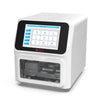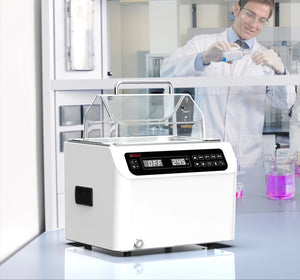Polymerase Chain Reaction (PCR) is used in nearly all biological and medical sciences.
PCR takes advantage of the ability of DNA polymerase to generate new strands of DNA (target sequence) complementary to a template.
By the end of the PCR reaction, the target sequence will have billions of copies.
Despite its incredible utility, PCR is the source of many laboratory frustrations due to nonspecific amplification.
This is often caused by imperfect calculations of the DNA melting temperature (Tm) and/or inadequate annealing conditions.
The simplified equation of calculating Tm (4(G+C) + 2(A+T)) does not factor in variables other than nucleotide content of primers and template DNA, such as the complexity and size of the input DNA, as well as the salt content of the solution.
In the end, the ideal temperature at which to denature DNA is obscured by these variables.
Luckily for molecular biologists everywhere, touchdown PCR (TD-PCR) was developed to increase product specificity, sensitivity, and yield.
TD-PCR or Touchdown PCR is a simple solution to Tm calculation limitations.
While a Tm estimate is still needed, TD-PCR optimizes the process by starting the first few reaction cycles at a higher annealing temperature (to favor specific binding of primers due to their high degree of complementarity, reducing the chance of non-specific primer binding) and slowly decreasing the annealing temperature to offset the inhibition of overall annealing (including specific binding of primers, and resulting in low yield). These two phases are described further:
Phase 1: For the first cycle, the annealing temperature is set to Tm +10°C. Successive cycles decrease the annealing temperature by 1°C until Tm (or Tm -5°C, 10-15 cycles total).
Phase 2: Standard PCR amplification continues for another 20-25 cycles using the final annealing temperature from phase 1. The total number of cycles for both phases should not exceed 30 cycles or else risk amplifying nonspecific products and/or the formation of primer dimers.
So why does TD-PCR work so well? It’s an excellent solution because it takes advantage of the exponential nature of the PCR reaction in which the initial annealing and amplification stages are critical for specificity and yield. Later cycles at lower temperatures produce fewer nonspecific products, shifting the reaction in favor of the desired product.
The main takeaway of TD-PCR is that annealing temperatures can be altered at the beginning and end of a PCR, with the following principles in mind:
- Too low an annealing temperature can promote formation of non-specific annealing, such as primer-dimer and off-target amplification.
- Too high an annealing temperature can inhibit overall primer annealing, including specific binding of primers, resulting in low yield.
For more information on gradient PCR or TD-PCR do not hesitate to contact Four E's USA.
















